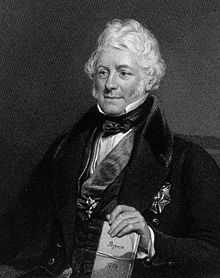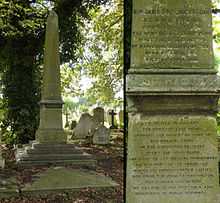James McGrigor

Sir James McGrigor, 1st Baronet FRSE FRS FRCPE MWS (9 April 1771 – 2 April 1858) was a Scottish physician, military surgeon and botanist, considered to be the man largely responsible for the creation of the Royal Army Medical Corps. He served as Rector of the University of Aberdeen.
Early life
McGrigor's father, Colquhoun, was a clothing merchant from Aberdeen.[1] McGrigor was born in Cromdale, Inverness-shire, and educated at Aberdeen Grammar School for five years,[2] and graduated from the University of Aberdeen in1778. Although his degree was notionally 'Master of Arts', it included some chemistry and biology, which inspired him to consider medicine as a career. He received medical training at the University of Edinburgh beginning in September 1789.[3] He received his MD degree while he was in London at the end of 1979 or the beginning of the following year.[4]
Army surgeon

Connaught Rangers
McGrigor joined the army as a surgeon in 1793, having purchased a commission in the Connaught Rangers, known at that time as the 88th Regiment of Foot, for £150. In February 1974, he was successfully examined for Membership of the Company of Surgeons of London.[5]
The Rangers assembled at Chatham, Kent docks early in 1794,[6] before sailing to Holland via Jersey, in order to support Dutch forces against the French. McGrigor was one of those aboard who contracted Typhus. He recovered sufficiently to organise the construction of a hospital facility in a converted local church, before he was sent back to the UK following a second bout of illness, whereupon he was promoted and given greater responsibilities.[7]
He was attached to the force that sailed to the West Indies in mid 1795, but due to an administrative mixup, missed the departure of his ship, and arrived subsequently on a different vessel. He was given mainly administrative duties, including the compilation of data on the causes of sickness in the deployed force, which were mainly yellow fever and malaria.[8]
After a period of internal security duties in Yorkshire, the Rangers sailed to India, to be attached to a force including a East India Company component; in order to make it easier for McGrigor to lead the combined medical services, he was given an honorary rank in the Company. He instituted a policy of bathing of sick soldiers, as a result of which he noticed the signs of an outbreak of bubonic plague, and directed the construction of segregated accommodation for those affected by it.[9] Trachoma[10] was also a problem, as was guinea worm. The force left Bombay in January 1803, and landed in Egypt, after which McGrigor returned to the UK.[11]
Spain and Portugal
In 1811, he was appointed Surgeon-General for the Duke of Wellington's army in Spain and Portugal during the Peninsular Wars (1808–14).
Director-General
McGrigor returned to Britain before the Battle of Waterloo, and was knighted (1814). He went on to serve as Director-General of the Army Medical Service (1815–51) and did much to reform that department. (He was succeeded in that post by Andrew Smith, who had at one time been McGrigor's Special Assistant since 1830.)[12] McGrigor introduced the stethoscope in 1821, set up field hospitals for those injured in action, and generally improved the standards of cleanliness and hygiene. His autobiography was published in 1861. An obelisk to his memory has been placed in Aberdeen and is now in Duthie Park.[13] A statue was erected in Westminster, and later moved to the Royal Military Academy Sandhurst.
References
- ↑ Miles, p. 57
- ↑ Miles, p. 33
- ↑ Miles, p. 34
- ↑ Miles, p. 34, citing Pettigrew, T (1840) Sir James McGrigor. Medical Portrait Gallery: Biographical Memoirs of physicians, surgeons etc who have contributed to the advancement of medical science. Vol 4 pp.1-12
- ↑ Miles, p. 35, citing Blanco.
- ↑ Miles, p. 39
- ↑ Miles, p. 39
- ↑ Miles, p. 40
- ↑ Miles, p. 41
- ↑ Miles, p. 41
- ↑ Miles, p. 44
- ↑ Miles, p. 37
- ↑ "Entry". Gazetteer for Scotland. Retrieved 6 December 2010.
Further reading
- Blanco, Richard L. Wellington's Surgeon General; Sir James McGrigor. Durham, N.C., Duke University Press, 1974, 8vo., pp. xiv.
- McGrigor, Sir James (ed. Mary McGrigor). The Scalpel and the Sword: Sir James McGrigor: The Autobiography of the Father of Army Medicine edited by Mary McGrigor. Dalkeith Scottish Cultural Press, 2000. See review by Martin Howard
- Miles, A E W The Accidental Birth of Military Medicine: The Origins of the Royal Army Medical Corps. Civic Books, 2009
External links
| Wikimedia Commons has media related to James McGrigor. |
| Baronetage of the United Kingdom | ||
|---|---|---|
| Preceded by New creation |
Baronet (of Campden Hill) 1831–1858 |
Succeeded by James Rhoderic Duff McGrigor |